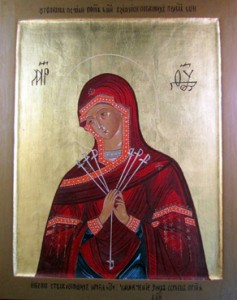 A Western theme, which was adopted in the 17th century by the Eastern Orthodox Church. It depicts the words of the old Simon who spoke to the Mother of God when she presented her son in the temple: ‘Yea, a sword shall pierce through thy own soul also’ (Luke 2:35). Seven white swords pierce her, representing the seven sorrows of Mary: the flight into Egypt, the prophecy in the temple, the twelve-year old Christ in the temple, the Crucifixion, the descent from the Cross, the burial, as well as the piercing of her soul.
A Western theme, which was adopted in the 17th century by the Eastern Orthodox Church. It depicts the words of the old Simon who spoke to the Mother of God when she presented her son in the temple: ‘Yea, a sword shall pierce through thy own soul also’ (Luke 2:35). Seven white swords pierce her, representing the seven sorrows of Mary: the flight into Egypt, the prophecy in the temple, the twelve-year old Christ in the temple, the Crucifixion, the descent from the Cross, the burial, as well as the piercing of her soul.
Size: 27 x 35 cm. ●
![]() The Flowering of Moldavia.
The Flowering of Moldavia.